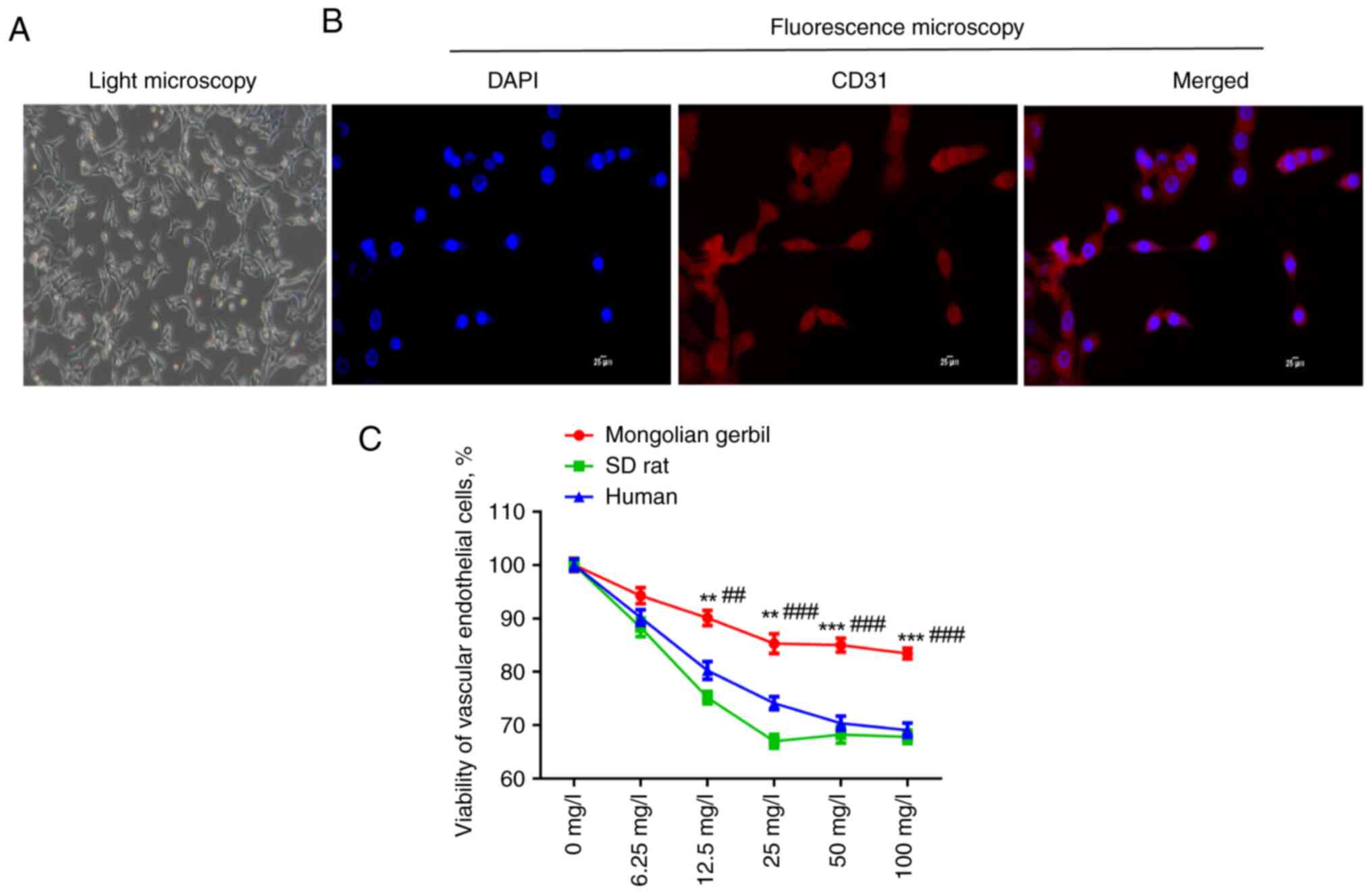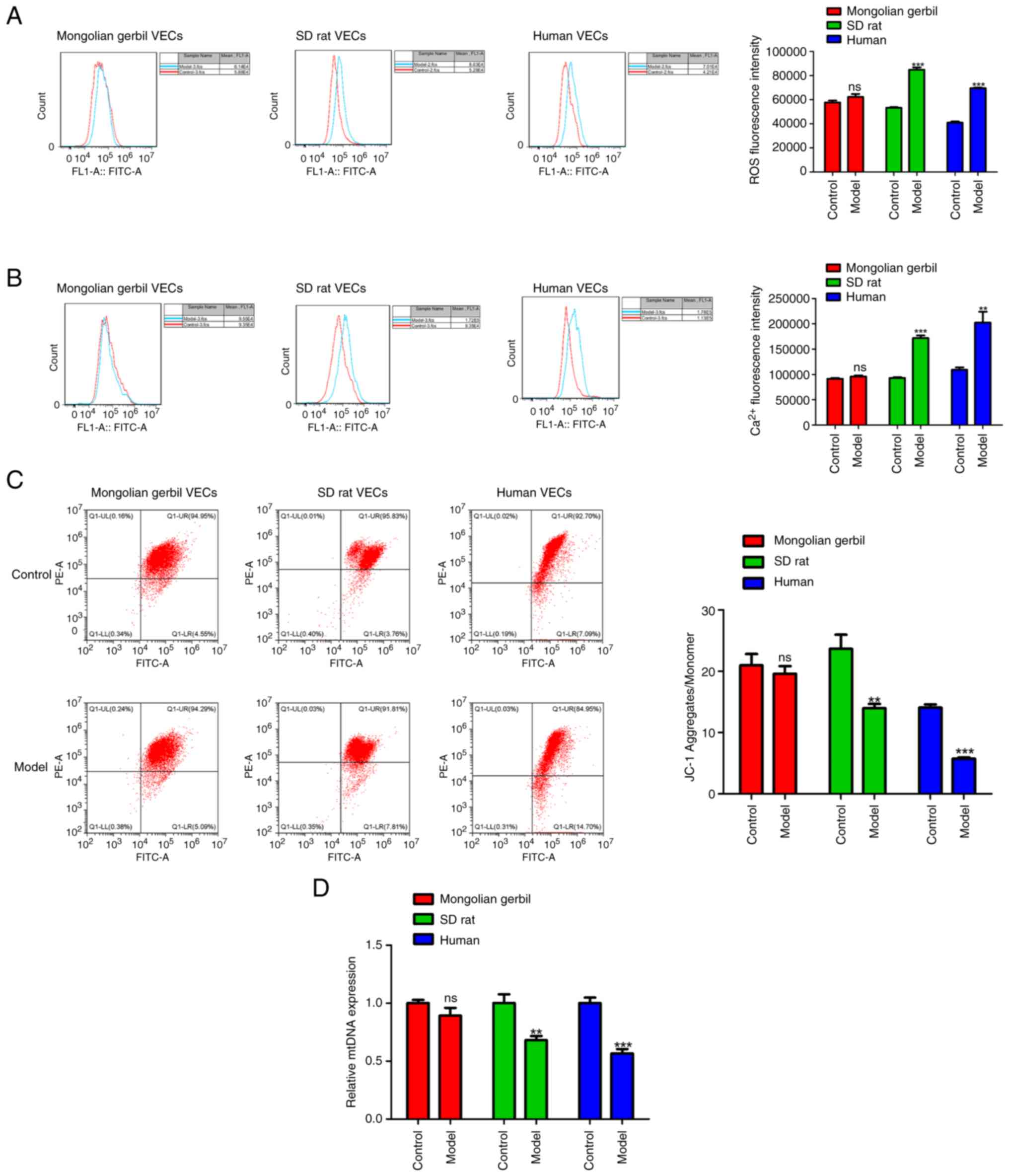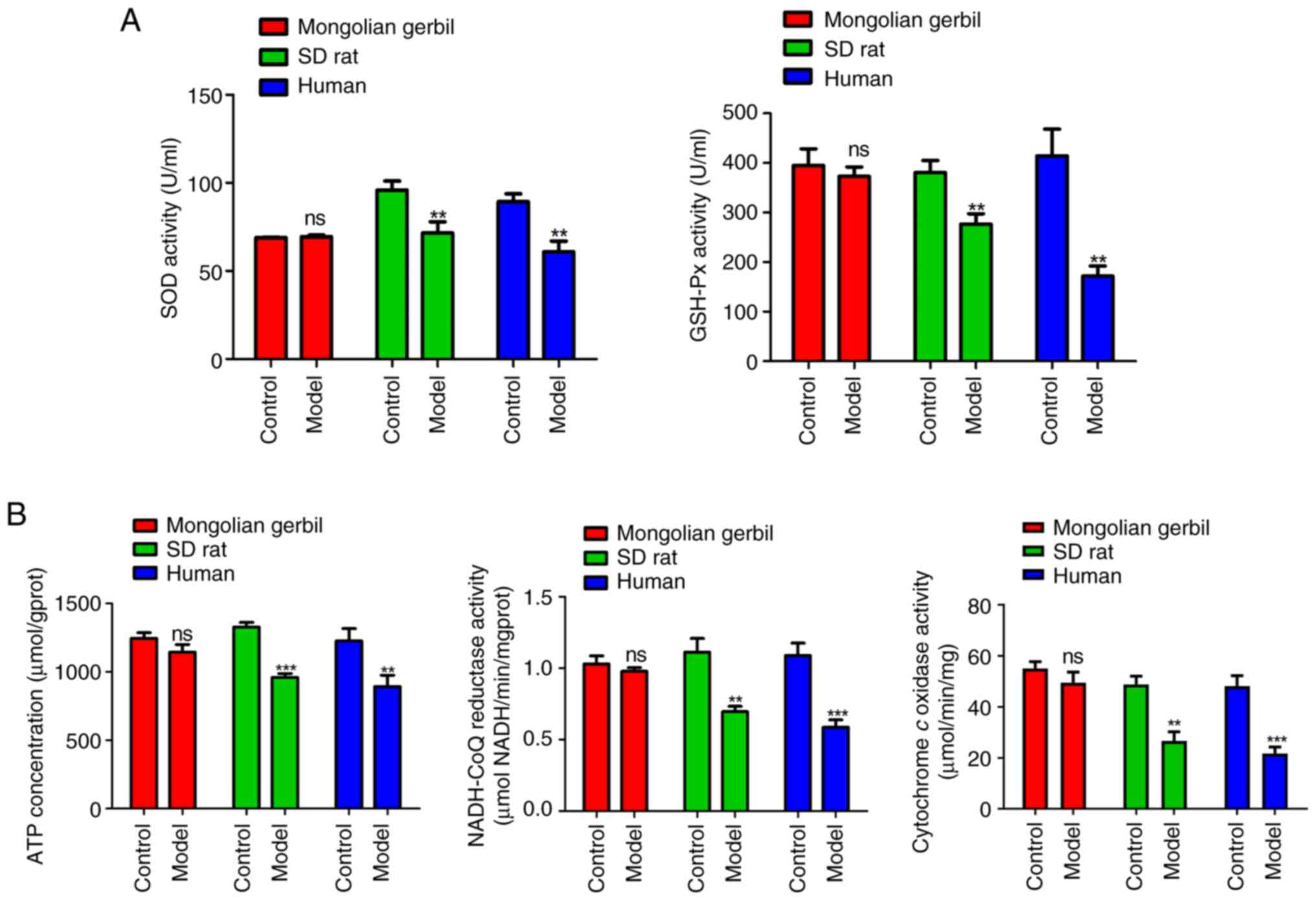|
1
|
Thomas H, Diamond J, Vieco A, Chaudhuri S,
Shinnar E, Cromer S, Perel P, Mensah GA, Narula J, Johnson CO, et
al: Global atlas of cardiovascular disease 2000-2016: The path to
prevention and control. Glob Heart. 13:143–163. 2018.PubMed/NCBI View Article : Google Scholar
|
|
2
|
McBride HM, Neuspiel M and Wasiak S:
Mitochondria: More than just a powerhouse. Curr Biol. 16:R551–R560.
2006.PubMed/NCBI View Article : Google Scholar
|
|
3
|
Bravo-Sagua R, Parra V, Lopez-Crisosto C,
Diaz P, Quest AF and Lavandero S: Calcium transport and signaling
in mitochondria. Compr Physiol. 7:623–634. 2017.PubMed/NCBI View Article : Google Scholar
|
|
4
|
Chien Y, Rosal K and Chung BC: Function of
CYP11A1 in the mitochondria. Mol Cell Endocrinol. 441:55–61.
2017.PubMed/NCBI View Article : Google Scholar
|
|
5
|
Blajszczak C and Bonini MG: Mitochondria
targeting by environmental stressors: Implications for redox
cellular signaling. Toxicology. 391:84–89. 2017.PubMed/NCBI View Article : Google Scholar
|
|
6
|
Li R, Jia Z and Trush MA: Defining ROS in
biology and medicine. React Oxyg Species (Apex). 1:9–21.
2016.PubMed/NCBI View Article : Google Scholar
|
|
7
|
Suarez-Rivero JM, Pastor-Maldonado CJ,
Povea-Cabello S, Álvarez-Córdoba M, Villalón-García I,
Talaverón-Rey M, Suárez-Carrillo A, Munuera-Cabeza M and
Sánchez-Alcázar JA: From mitochondria to atherosclerosis: The
inflammation path. Biomedicines. 9(285)2021.PubMed/NCBI View Article : Google Scholar
|
|
8
|
Wu X, Zhang H, Qi W, Zhang Y, Li J, Li Z,
Lin Y, Bai X, Liu X, Chen X, et al: Nicotine promotes
atherosclerosis via ROS-NLRP3-mediated endothelial cell pyroptosis.
Cell Death Dis. 9(171)2018.PubMed/NCBI View Article : Google Scholar
|
|
9
|
He X, Fan X, Bai B, Lu N, Zhang S and
Zhang L: Pyroptosis is a critical immune-inflammatory response
involved in atherosclerosis. Pharmacol Res.
165(105447)2021.PubMed/NCBI View Article : Google Scholar
|
|
10
|
Wu H, Wang Y, Li W, Chen H, Du L, Liu D,
Wang X, Xu T, Liu L and Chen Q: Deficiency of mitophagy receptor
FUNDC1 impairs mitochondrial quality and aggravates dietary-induced
obesity and metabolic syndrome. Autophagy. 15:1882–1898.
2019.PubMed/NCBI View Article : Google Scholar
|
|
11
|
Xu LD, Zhang F, Chen C, Peng L, Luo WT,
Chen R, Xu P and Huang YW: Revisiting the mongolian gerbil model
for hepatitis E virus by reverse genetics. Microbiol Spectr.
10(e0219321)2022.PubMed/NCBI View Article : Google Scholar
|
|
12
|
Zhang X, Wang C, He Y, Xing J, He Y, Huo
X, Fu R, Lu X, Liu X, Lv J, et al: Establishment of noninvasive
methods for the detection of Helicobacter pylori in
mongolian gerbils and application of main laboratory gerbil
populations in China. Biomed Res Int. 2022(6036457)2022.PubMed/NCBI View Article : Google Scholar
|
|
13
|
Hong W, Zhang T, Yan J, Yu J, He B, Wu L,
Yao K, Mao W and Chen Z: Bioinformatics analysis of an animal model
of diet-induced nonalcoholic fatty liver disease with rapid
progression. Exp Biol Med (Maywood). 247:263–275. 2022.PubMed/NCBI View Article : Google Scholar
|
|
14
|
Jia F, Liu Y, Dou X, Du C, Mao T and Liu
X: Liensinine inhibits osteosarcoma growth by ROS-mediated
suppression of the JAK2/STAT3 signaling pathway. Oxid Med Cell
Longev. 2022(8245614)2022.PubMed/NCBI View Article : Google Scholar
|
|
15
|
Kong X, Li M, Shao K, Yang Y, Wang Q and
Cai M: Progesterone induces cell apoptosis via the
CACNA2D3/Ca2+/p38 MAPK pathway in endometrial cancer.
Oncol Rep. 43:121–132. 2020.PubMed/NCBI View Article : Google Scholar
|
|
16
|
Yang H, Cui Y, Tang Y, Tang X, Yu X, Zhou
J, Yin Q and Shentu X: Cytoprotective role of humanin in lens
epithelial cell oxidative stress-induced injury. Mol Med Rep.
22:1467–1479. 2020.PubMed/NCBI View Article : Google Scholar
|
|
17
|
Jeng JY, Yeh TS, Lee JW, Lin SH, Fong TH
and Hsieh RH: Maintenance of mitochondrial DNA copy number and
expression are essential for preservation of mitochondrial function
and cell growth. J Cell Biochem. 103:347–357. 2008.PubMed/NCBI View Article : Google Scholar
|
|
18
|
Jeong EM, Chung J, Liu H, Go Y, Gladstein
S, Farzaneh-Far A, Lewandowski ED and Dudley SC Jr: Role of
mitochondrial oxidative stress in glucose tolerance, insulin
resistance and cardiac diastolic dysfunction. J Am Heart Assoc.
5(e003046)2016.PubMed/NCBI View Article : Google Scholar
|
|
19
|
Wasan KM, Najafi S, Peteherych KD and
Pritchard PH: Effects of a novel hydrophilic phytostanol analog on
plasma lipid concentrations in gerbils. J Pharm Sci. 90:1795–1799.
2001.PubMed/NCBI View
Article : Google Scholar
|
|
20
|
Suckling KE and Jackson B: Animal models
of human lipid metabolism. Prog Lipid Res. 32:1–24. 1993.PubMed/NCBI View Article : Google Scholar
|
|
21
|
Ramachandran HD, Narasimhamurthy K and
Raina PL: Modulation of cholesterol induced hypercholesterolemia
through dietary factors in Indian desert gerbils (Meriones
hurrianae). Nutrition Res. 23:245–256. 2003.
|
|
22
|
Chen HI, Hu WS, Hung MY, Ou HC, Huang SH,
Hsu PT, Day CH, Lin KH, Viswanadha VP, Kuo WW and Huang CY:
Protective effects of luteolin against oxidative stress and
mitochondrial dysfunction in endothelial cells. Nutr Metab
Cardiovasc Dis. 30:1032–1043. 2020.PubMed/NCBI View Article : Google Scholar
|
|
23
|
Marchio P, Guerra-Ojeda S, Vila JM,
Aldasoro M, Victor VM and Mauricio MD: Targeting early
atherosclerosis: A focus on oxidative stress and inflammation. Oxid
Med Cell Longev. 2019(8563845)2019.PubMed/NCBI View Article : Google Scholar
|
|
24
|
Victor VM, Apostolova N, Herance R,
Hernandez-Mijares A and Rocha M: Oxidative stress and mitochondrial
dysfunction in atherosclerosis: Mitochondria-targeted antioxidants
as potential therapy. Curr Med Chem. 16:4654–4667. 2009.PubMed/NCBI View Article : Google Scholar
|
|
25
|
Batty M, Bennett MR and Yu E: The role of
oxidative stress in atherosclerosis. Cells. 11(3843)2022.PubMed/NCBI View Article : Google Scholar
|
|
26
|
Ciccarelli G, Conte S, Cimmino G, Maiorano
P, Morrione A and Giordano A: Mitochondrial dysfunction: The hidden
player in the pathogenesis of atherosclerosis? Int J Mol Sci.
24(1086)2023.PubMed/NCBI View Article : Google Scholar
|
|
27
|
Shaito A, Aramouni K, Assaf R, Parenti A,
Orekhov A, Yazbi AE, Pintus G and Eid AH: Oxidative Stress-induced
endothelial dysfunction in cardiovascular diseases. Front Biosci
(Landmark Ed). 27(105)2022.PubMed/NCBI View Article : Google Scholar
|
|
28
|
Ekstrand M, Gustafsson Trajkovska M,
Perman-Sundelin J, Fogelstrand P, Adiels M, Johansson M,
Mattsson-Hultén L, Borén J and Levin M: Imaging of intracellular
and extracellular ROS levels in atherosclerotic mouse aortas ex
vivo: Effects of lipid lowering by diet or atorvastatin. PLoS One.
10(e0130898)2015.PubMed/NCBI View Article : Google Scholar
|
|
29
|
Mallat Z, Corbaz A, Scoazec A, Besnard S,
Lesèche G, Chvatchko Y and Tedgui A: Expression of interleukin-18
in human atherosclerotic plaques and relation to plaque
instability. Circulation. 104:1598–1603. 2001.PubMed/NCBI View Article : Google Scholar
|
|
30
|
Feno S, Butera G, Reane DV, Rizzuto R and
Raffaello A: Crosstalk between calcium and ROS in
pathophysiological conditions. Oxid Med Cell Longev.
2019(9324018)2019.PubMed/NCBI View Article : Google Scholar
|
|
31
|
Bou-Teen D, Kaludercic N, Weissman D,
Turan B, Maack C, Di Lisa F and Ruiz-Meana M: Mitochondrial ROS and
mitochondria-targeted antioxidants in the aged heart. Free Radic
Biol Med. 167:109–124. 2021.PubMed/NCBI View Article : Google Scholar
|
|
32
|
Madreiter-Sokolowski CT, Thomas C and
Ristow M: Interrelation between ROS and Ca2+ in aging
and age-related diseases. Redox Biol. 36(101678)2020.PubMed/NCBI View Article : Google Scholar
|
|
33
|
Gorlach A, Bertram K, Hudecova S and
Krizanova O: Calcium and ROS: A mutual interplay. Redox Biol.
6:260–271. 2015.PubMed/NCBI View Article : Google Scholar
|
|
34
|
Di Lisa F and Bernardi P: A CaPful of
mechanisms regulating the mitochondrial permeability transition. J
Mol Cell Cardiol. 46:775–780. 2009.PubMed/NCBI View Article : Google Scholar
|
|
35
|
Biasutto L, Azzolini M, Szabo I and
Zoratti M: The mitochondrial permeability transition pore in AD
2016: An update. Biochim Biophys Acta. 1863:2515–2530.
2016.PubMed/NCBI View Article : Google Scholar
|
|
36
|
Moran M, Moreno-Lastres D, Marin-Buera L,
Arenas J, Martin MA and Ugalde C: Mitochondrial respiratory chain
dysfunction: implications in neurodegeneration. Free Radic Biol
Med. 53:595–609. 2012.PubMed/NCBI View Article : Google Scholar
|
|
37
|
Nickel A, Kohlhaas M and Maack C:
Mitochondrial reactive oxygen species production and elimination. J
Mol Cell Cardiol. 73:26–33. 2014.PubMed/NCBI View Article : Google Scholar
|
|
38
|
Jena AB, Samal RR, Bhol NK and Duttaroy
AK: Cellular Red-Ox system in health and disease: The latest
update. Biomed Pharmacother. 162(114606)2023.PubMed/NCBI View Article : Google Scholar
|












